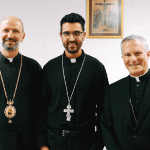Quoth he:
Up until now I had avoided commenting directly on Pope Francis’s Amoris Laetitia (AL). As a former tribunal canonist whose experience is mainly within the Canadian and American context, I was much more interested in Pope Francis’s 2015 reforms simplifying marriage tribunal procedure. These reforms have had much greater effect on any day-to-day ministry in a developed world context than AL’s controversial footnote, in my opinion.
In assisting priest friends with tribunal-related ministry in their parishes (particularly during Canada’s summer months when it gives me an excuse to ride our gorgeous secondary highways on my Indian Scout motorcycle), I have yet to personally encounter a pastoral situation following the pope’s tribunal procedure reform that would have made AL necessary. Or even a possibility.
MARRIAGE AND DISSOLUTION
Now the first thing to keep in mind is that the Holy Father’s critics, like many other Catholics, often confuse their knowledge and terminology. To begin, an annulment (or declaration of invalidity) is a judicial judgment stating that a marriage is invalid. Whereas a dissolution would be the act of dissolving a valid marriage. Dissolution is different from a declaration of invalidity. A marriage is only dissolved if it is presumed valid to begin with. Otherwise, there is no marriage to dissolve.
Here one must distinguish between a sacramental marriage and a natural marriage. A natural marriage is a valid marriage between a man and a woman, in which either one or both parties is non-baptised. Where both parties are baptised validly, the marriage by the very fact of both parties’ valid baptism becomes a sacramental marriage.
Furthermore we have to distinguish between a marriage that is ratified (consummated) and one that is not. Now each of these distinctions is important background to the discussion because the Church is capable of dissolving many types of marriage. This is traditional teaching going back well before Vatican II.
For example, St Paul discusses dissolution of marriage in 1 Cor 7:12-15 as follows:
“12 To the rest I say, not the Lord, that if any brother has a wife who is an unbeliever, and she consents to live with him, he should not divorce her. 13 If any woman has a husband who is an unbeliever, and he consents to live with her, she should not divorce him. 14 For the unbelieving husband is consecrated through his wife, and the unbelieving wife is consecrated through her husband. Otherwise, your children would be unclean, but as it is they are holy. 15 But if the unbelieving partner desires to separate, let it be so; in such a case the brother or sister is not bound. For God has called us[a] to peace.”
This particular variation of marriage dissolution is popularly called the Pauline privilege in accordance with St Paul’s teaching above. Unlike a marriage annulment, the dissolution of a marriage by the Church must always be in favour of a new bond. Within the Pauline privilege, this new marriage is with a baptized Christian. The Pauline Privilege takes place at the diocesan level, whereas other types of dissolution (Petrine Privilege, Privilege of the Faith) go to Rome. Of course God can always dissolve a marriage through the death of one of the spouses.
For more information on this particular topic, please see the following piece Jacqui Sober Rapp and I co-authored for Envoy Magazine several years ago: http://patrickmadrid.com/tag/jacqueline-rapp/
What is important for the combox discussion over AL is that any natural marriage or unconsummated sacramental marriage can be dissolved by the Church. This includes marriages previously consummated as natural marriages, but never consummated as sacramental marriages.
For instance, Terrance is baptized. Sharon is not. They marry, consummate their marriage, and have two kids together. Terrance then comes out of the closet and runs off with secret lover Phil, a fellow Canadian who he met in a support group for Canadians suffering from a particular digestive ailment, divorcing the unbaptized Sharon.
Sharon later meets Randy who like much of Colorado is a devout Evangelical. The previously non-baptized Sharon is baptized Evangelical and she and Randy marry in an Evangelical church. Technically, the Church would now recognize Sharon as sacramentally married to her first husband Terrance (since she and Terrance are now both baptized validly) even though during Sharon’s period as a baptized Christian she has always been with second husband Randy, while Terrance during the same time frame has been in a same-sex partnership with Phil.
Of course Randy and Sharon are Evangelical for the first ten years of their marriage, so Catholic teaching is not something they really worry about personally. But driving home from work one day, Randy happens to tune into the Catholic radio station and hears two Catholic authors named Mark Sheaand Dave Armstrong kvetching away on their conversion to Catholicism. Randy tells Sharon, they listen to the re-broadcast that evening, and the next day they run to their nearest Catholic parish where they introduce themselves to the priest and announce their intention to become Catholic. A few weeks later Father contacts me to sort out their marriage situation.
In this case we could forward their file to Rome and request dissolution of Terrance and Sharon’s sacramental marriage in favour of her second and current civil marriage to Randy. She and Randy wish to be received in the Catholic Church and she and Terrance have never slept together following Sharon’s baptism. Thus Sharon’s first marriage to Terrance, while consummated as a natural marriage, was never consummated as a sacramental one.
RATIFIED SACRAMENTAL MARRIAGE
On to marriages that are sacramental and ratified (consummated) as such. According to traditional Latin theology, this can only be dissolved by God through the death of one of the parties. It cannot be dissolved by the Church. Whereas Eastern theology, citing Chrysostom, leaves the door open to “Epikia” and the possibility of the Church dissolving a ratified sacramental marriage. However, this Eastern Orthodox appeal to epikia is not recognized by the Roman Catholic Church.
CASES COVERED UNDER AMORIS LAETITIA
Where AL becomes a possibility, if I understand the Holy Father’s intention correctly, is in cases where a couple believe a prior marriage to be invalid but for some reason (physically, financially, morally, etc) they cannot approach a Catholic tribunal. For instance, we are privileged as Catholics in the developed world in that every diocese has access to a functioning tribunal. Moreover, local dioceses insure the faithful have the means to approach them. This often is NOT the case in the developing world.
This can be painful pastorally when a pastoral with canonical experience has a pretty strong sense from years of ministry that a marriage is invalid, especially when the party has moved on to a new and stable union, and yet the pastor has no means of easily proving the marriage invalid because the person is a refugee from a dangerous regime, or the former spouse is in federal prison for statutory rape and correspondence is highly monitored by law enforcement.
Or, I am reminded of a situation reported recently by my friend Ross Earl Hoffman while carrying out Catholic missionary activity in Uganda. He requested donations to help a penniless mother of several young children whose husband abandoned them. In the developed world there is social assistance, in some parts of Uganda this woman could watch her children starve to death if she is unable to find another partner quickly. Remember this diocese may or may not have a canonist, let alone functioning tribunal. Likely she lacks the means to approach it anyway. Especially if she must travel a couple hundred miles by foot with a half dozen minor children in tow.
Even I am not this heartless as a canonist, traditionalist, and political conservative. My sense is that AL was intended precisely for these types of case.
This is a lot different than a Catholic professional in a committed marriage for 20 years with four kids having a midlife crisis, running away with his 20-something-year-old secretary, and then expecting to continue his role in the parish as a reader and extraordinary minister of the Eucharist. Or two wealthy pensioners shacked up and refusing to marry because they would lose some of their social security benefits despite having several RESP’s and company pensions upon which to draw. (And yes, I have faced this type of situation where my otherwise liberal bishop and judicial vicar at the time supported my taking a tough stand).
Thus Francis is really calling for pastoral common sense, in my opinion.
At this point my “summary” of the conversation with Mark is a bit longer than I had anticipated, so I will break it off here. The next instalment will address my thoughts on the text of AL itself. Please continue to part two by clicking here:
On to my thoughts surrounding the text of Amoris Laetitia’s controversial passage itself. Please note, as I repeated to Mark, Julian Barkin, and Suzanne Fortin throughout our conversation, I’m not quite sure how everything will eventually work itself out, only that it will. Thus some of what follows is speculative on how the “working out” might take place.
AN EXAMPLE FROM VATICAN II AND RELIGIOUS LIBERTY
To begin, in fairness to the critics, there are some interpretations that go further than previous popes allowed. But this is not the first time in Church history that positions seemed irreconcilable at first and subsequently the theological principle allowing their reconciliation became clear in hindsight. In fact, the Church’s foremost expert and apologist on Religious Liberty, as recognized as such by no less an authority as then-Cardinal Ratzinger, is a priest ordained by Archbishop Lefebvre who says the TLM almost exclusively. His name is Dom Basile Valuet and is a monk of Ste Madeleine du Barroux Benedictine monastery in France, which was restored by Dom Gerard Calvet. Many may recognize Dom Gerard as the co-founder with Archbishop Marcel Lefebvre and Abbe Paul Aulagnier of the Latin traditionalist movement post-Vatican II.
When Le Barroux monastery reconciled with the Church following Archbishop Lefebvre’s illicit 1988 episcopal consecrations, the monks–if I recall correctly–were allowed to suspend assent on Vatican II’s teaching on religious liberty provided they took the time to study the issue and draft a respectful and non-polemical statement identifying all their concerns and objections, and noting where Vatican II teaching contradicted previous Church teaching. Dom Gerard entrusted this task to Dom Basile, who was the most scholarly of Le Barroux’s monks. Dom Basile’s study eventually morphed into his doctoral thesis of almost 3,000 pages–including thousands of footnotes and hundreds of resources cited. At some point during his research the Holy Spirit opened Dom Basile’s eyes and he came to recognize religious liberty as implicit in Catholic teaching since the early Church.
Given the Eastern Tradition, which within the Catholic context and communion has always deferred to the Latin tradition but never been totally comfortable with it, I could see something similar happening with AL. I may be totally off here, in which case I will welcome any correction or better explanation from the Church. Yet what Pope Francis’s critics are upset about is a footnote to a paragraph where Pope Francis asks us not to use the law as cudgel to beat the faithful with.
To explain the footnote situation, let’s start with AL’s prior paragraphs prefacing paraph 305 containing the controversial footnote.
*********
294. “The choice of a civil marriage or, in many cases, of simple cohabitation, is often not motivated by prejudice or resistance to a sacramental union, but by cultural or contingent situations”. In such cases, respect also can be shown for those signs of love which in some way reflect God’s own love. We know that there is “a continual increase in the number of those who, after having lived together for a long period, request the celebration of marriage in Church. Simply to live together is often a choice based on a general attitude opposed to anything institutional or definitive; it can also be done while awaiting more security in life (a steady job and steady income).In some countries, de facto unions are very numerous, not only because of a rejection of values concerning the family and matrimony, but primarily because celebrating a marriage is considered too expensive in the social circumstances. As a result, material poverty drives people into de facto unions”.Whatever the case, “all these situations require a constructive response seeking to transform them into opportunities that can lead to the full reality of marriage and family in conformity with the Gospel. These couples need to be welcomed and guided patiently and discreetly”. That is how Jesus treated the Samaritan woman (cf. Jn 4:1-26): he addressed her desire for true love, in order to free her from the darkness in her life and to bring her to the full joy of the Gospel.
295. Along these lines, Saint John Paul II proposed the so-called “law of gradualness” in the knowledge that the human being “knows, loves and accomplishes moral good by different stages of growth”. This is not a “gradualness of law” but rather a gradualness in the prudential exercise of free acts on the part of subjects who are not in a position to understand, appreciate, or fully carry out the objective demands of the law.
For the law is itself a gift of God which points out the way, a gift for everyone without exception; it can be followed with the help of grace, even though each human being “advances gradually with the progressive integration of the gifts of God and the demands of God’s definitive and absolute love in his or her entire personal and social life”.
*******
Basically, in 1960’s America and Canada, the choice to live together without marriage was most likely a conscious choice to reject Church teaching and live sinfully. Most couples could afford to marry and raise a family together. Most of society went to church regularly and had a basic Christian understanding of marriage.What about two teenage orphans among India’s outcasts who have no money to afford a wedding but commit to one another and live their exclusive commitment long after most Christian marriages in our western developed countries have ended in divorce? Or what about a younger person raised in our culture today without any religious formation, and raised by a single parent or parents who have never cohabitated? To this generation, hooking up for sex, dating exclusively, moving in together, and then marrying if the relationship proves stable (which children making an appearance at any of the aforementioned stages) is all they have ever witnessed from mainstream society.
This is much different that what happened in the 1960’s when young people from a rich nation were willfully and obstinately rejecting Church teaching. Thus pastorally Pope Francis is asking us not to treat these cases equivantly. That is, not to conclude a couple have received a good Christian upbringing, or have the financial means, to marry. Don’t treat them like their civil marriage or status as a cohabitating couple is an intentional and obstinate rejection of Church teaching. Rather, get to know them and their particular circumstances, and accompany them in their journey to Christian marriage.
With respect to a divorced person who has entered a new union, AL paragraph 298 similarly recognizes situations and criteria that assists a pastor in assessing how to proceed pastorally:
********
298. The divorced who have entered a new union, for example, can find themselves in a variety of situations, which should not be pigeonholed or fit into overly rigid classifications leaving no room for a suitable personal and pastoral discernment.One thing is a second union consolidated over time, with new children, proven fidelity, generous self giving, Christian commitment, a consciousness of its irregularity and of the great difficulty of going back without feeling in conscience that one would fall into new sins. The Church acknowledges situations “where, for serious reasons, such as the children’s upbringing, a man and woman cannot satisfy the obligation to separate”. There are also the cases of those who made every effort to save their first marriage and were unjustly abandoned, or of “those who have entered into a second union for the sake of the children’s upbringing, and are sometimes subjectively certain in conscience that their previous and irreparably broken marriage had never been valid”. Another thing is a new union arising from a recent divorce, with all the suffering and confusion which this entails for children and entire families, or the case of someone who has consistently failed in his obligations to the family. It must remain clear that this is not the ideal which the Gospel proposes for marriage and the family. The Synod Fathers stated that the discernment of pastors must always take place “by adequately distinguishing”, with an approach which “carefully discerns situations”. We know that no “easy recipes” exist.
**********
As one can see, AL’s controversial paragraph above can really be summarized as “Pastors, know your flock, know the particulars of their situation, and respond appropriately and with compassion.”Now the most controversial of AL’s paragraphs is 305, which contains the footnote opening up the possibility of couples in irregular unions described above (par 298) receiving sacramental assistance, particularly the Eucharist.
Here is the paragraph in question, footnotes removed:
*********
305. For this reason, a pastor cannot feel that it is enough simply to apply moral laws to those living in “irregular” situations, as if they were stones to throw at people’s lives. This would bespeak the closed heart of one used to hiding behind the Church’s teachings, “sitting on the chair of Moses and judging at times with superiority and superficiality difficult cases and wounded families”. Along these same lines, the International Theological Commission has noted that “natural law could not be presented as an already established set of rules that impose themselves a priori on the moral subject; rather, it is a source of objective inspiration for the deeply personal process of making decisions”. Because of forms of conditioning and mitigating factors, it is possible that in an objective situation of sin – which may not be subjectively culpable, or fully such – a person can be living in God’s grace, can love and can also grow in the life of grace and charity, while receiving the Church’s help to this end. Discernment must help to find possible ways of responding to God and growing in the midst of limits. By thinking that everything is black and white, we sometimes close off the way of grace and of growth, and discourage paths of sanctification which give glory to God. Let us remember that “a small step, in the midst of great human limitations, can be more pleasing to God than a life which appears outwardly in order, but moves through the day without confronting great difficulties”. The practical pastoral care of ministers and of communities must not fail to embrace this reality.**********
Now for controversial footnote 351. It is found at the end of the following sentence in paragraph 305: “Because of forms of conditioning and mitigating factors, it is possible that in an objective situation of sin – which may not be subjectively culpable, or fully such – a person can be living in God’s grace, can love and can also grow in the life of grace and charity, while receiving the Church’s help to this end.”351Under footnote 351, Pope Francis states as follows: “In certain cases, this can include the help of the sacraments. Hence, ‘I want to remind priests that the confessional must not be a torture chamber, but rather an encounter with the Lord’s mercy’ (Apostolic Exhortation Evangelii Gaudium [24 November 2013], 44: AAS 105 [2013], 1038). I would also point out that the Eucharist ‘is not a prize for the perfect, but a powerful medicine and nourishment for the weak’ (ibid., 47: 1039).”
Footnote 351 is the crux of what is being objected to by the Holy Father’s critics. Especially as it appears to contradict the following paragraph (84) from St John Paul II’s Familiaris Consortio:
******
However, the Church reaffirms her practice, which is based upon Sacred Scripture, of not admitting to Eucharistic Communion divorced persons who have remarried. They are unable to be admitted thereto from the fact that their state and condition of life objectively contradict that union of love between Christ and the Church which is signified and effected by the Eucharist. Besides this, there is another special pastoral reason: if these people were admitted to the Eucharist, the faithful would be led into error and confusion regarding the Church’s teaching about the indissolubility of marriage.Reconciliation in the sacrament of Penance which would open the way to the Eucharist, can only be granted to those who, repenting of having broken the sign of the Covenant and of fidelity to Christ, are sincerely ready to undertake a way of life that is no longer in contradiction to the indissolubility of marriage. This means, in practice, that when, for serious reasons, such as for example the children’s upbringing, a man and a woman cannot satisfy the obligation to separate, they “take on themselves the duty to live in complete continence, that is, by abstinence from the acts proper to married couples.”
*********
At present, I am not completely sure how these two papal statements will eventually reconcile. However, I am confident that guided by the Holy Spirit our pastors, theologians, and canonists will figure it out. Much like Dom Basile Valuet figured out how to reconcile religious liberty, and in doing so earning high praise from the future Pope Benedict XVI.Speaking personally as a Byzantine Catholic, I think the issue with Pope Francis here and with other Catholic controversies such as the environment and social justice is not that Pope Francis is liberal–or at least more liberal than his two most recent predecessors–and more that he is much more Orthodox in his theology–as in Eastern Orthodox. I can understand why this is somewhat unsettling to certain western fundamentalists. But faithful Catholics ought to start with the presumption that any apparent theological contradiction between Francis and St John Paul II can be reconciled. That is, let us start with the hermeneutic of continuity in accordance with St Ignatius’s principle of charitable interpretation and not an assumption of guilt.
Again, I am not sure ultimately how the details will be worked out. And on the one hand I am a big fan of St John Paul II’s Familiaris Consortio–a papal document that has shaped me as a canonist and as a Catholic apologist on marriage and family issues. On the other, I am also a Byzantine Catholic catechist, quite familiar with the more Eastern “sacraments are medicine for the sick, not prizes for the most saintly” approach to pastoral praxis.
So for me the apparent conflict between Pope Francis and St John Paul II is one that I experience interiorly, and have done so since before Francis’ pontificate. The fact that East and West have differed on this approach historically, and that today there are good popes on either side, tells me that there must be a way of reconciling the two. Until the Church sorts out the fine details, which I think she will in the next five to ten years, my approach will be to interpret everything through AL paragraphs 307 and 308:
******
307. In order to avoid all misunderstanding, I would point out that in no way must the Church desist from proposing the full ideal of marriage, God’s plan in all its grandeur: “Young people who are baptized should be encouraged to understand that the sacrament of marriage can enrich their prospects of love and that they can be sustained by the grace of Christ in the sacrament and by the possibility of participating fully in the life of the Church”. A lukewarm attitude, any kind of relativism, or an undue reticence in proposing that ideal, would be a lack of fidelity to the Gospel and also of love on the part of the Church for young people themselves. To show understanding in the face of exceptional situations never implies dimming the light of the fuller ideal, or proposing less than what Jesus offers to the human being. Today, more important than the pastoral care of failures is the pastoral effort to strengthen marriages and thus to prevent their breakdown.308. At the same time, from our awareness of the weight of mitigating circumstances – psychological, historical and even biological – it follows that “without detracting from the evangelical ideal, there is a need to accompany with mercy and patience the eventual stages of personal growth as these progressively appear”, making room for “the Lord’s mercy, which spurs us on to do our best”. I understand those who prefer a more rigorous pastoral care which leaves no room for confusion. But I sincerely believe that Jesus wants a Church attentive to the goodness which the Holy Spirit sows in the midst of human weakness, a Mother who, while clearly expressing her objective teaching, “always does what good she can, even if in the process, her shoes get soiled by the mud of the street”.
The Church’s pastors, in proposing to the faithful the full ideal of the Gospel and the Church’s teaching, must also help them to treat the weak with compassion, avoiding aggravation or unduly harsh or hasty judgements. The Gospel itself tells us not to judge or condemn (cf. Mt 7:1; Lk 6:37). Jesus “expects us to stop looking for those personal or communal niches which shelter us from the maelstrom of human misfortune, and instead to enter into the reality of other people’s lives and to know the power of tenderness. Whenever we do so, our lives become wonderfully complicated”.
***
So as you can see above two paragraphs, Pope Francis has asked us not to shy away from the Church’s traditional teaching on marriage in terms of upholding it as the ideal. Thus I will likely approach AL differently depending upon what particular hat I am wearing in the ministry to which God calls me in the moment.1 – In terms of “deep theology” within East-West ecumenism or the occasional guest lecture to a graduate-level theology course, I will note the apparent tension within recent papal documents and ongoing work to reconcile the reconcil both positions.
2 – In terms of parish catechist, adult faith formator, and retired Catholic apologist who occasionally wanders into online debate, I will stick with St John Paul II in holding up the traditional RC teaching as the ideal.
3 – As a lay volunteer with a graduate degree in pastoral theology who is sometimes asked to assist local priest friends when they are too swamped to respond to every pastoral call, I will go with Francis’ call for pastoral discernment when there are mitigating circumstances.
4 – And in terms of ministry as a canonist, this was part of a separate reform instituted by Pope Francis which my bishop and I support wholeheartedly and which he has already implemented fully in our tribunal practice.
But this is just me. It may not be the perfect solution, and the Church may need to offer me some additional guidance and correction along the way, which I would welcome with relief. Until then, this is how I intend to proceed according to my limited discernment and understanding, after prayer and reflection. I believe this approach best reflects the mind of the Church as expressed through Pope Francis, St John Paul II, and my bishop.
As the old Latin expression goes, “The salvation of souls is the highest law.” I believe this is the approach that Pope Francis has adopted in AL, and has also asked the Church’s pastoral leadership at every level to adopt.











